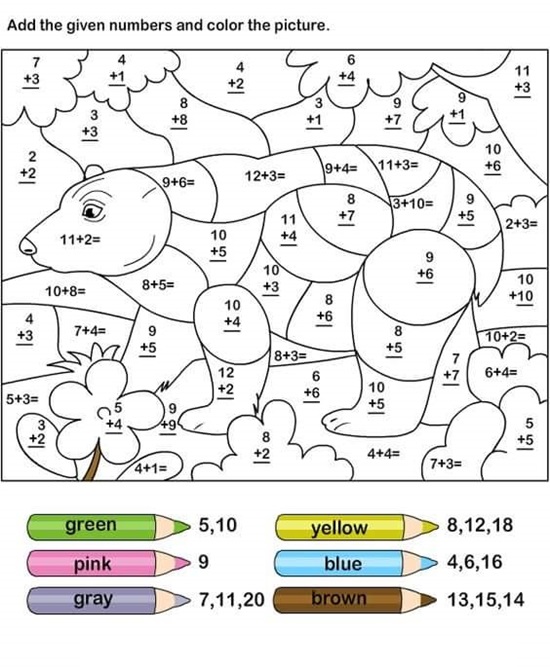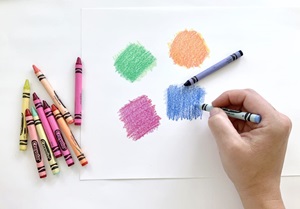Add and color activities may seem simple, but they are such a fun and engaging way for children to learn and practice basic math skills while unleashing their creativity. These activities combine problem-solving with artistic expression, making them a hit among kids of all ages. By solving simple addition problems to determine which colors to use, children strengthen their cognitive abilities, boost concentration, and develop fine motor skills. Whether done independently or as a group, add and color activities provide endless opportunities for learning and social interaction. This article explores the benefits of these activities, how to get started, tailoring them to different age groups, and the joy of sharing the experience in a group setting.
In this article we will go through a few things, such as the benefits of this activity, how to get started and how to tailor it to different age groups. We will also point you to some great websites with amazing resources that you can download. If you are thinking about making this a group activity, there are also some tips for you and some invitation templates. So, let’s get started!
Benefits of Add and Color Activities
Cognitive Development and Math Skills
Add and color activities are an excellent way to introduce children to the basics of arithmetic in an enjoyable and interactive manner. By solving simple addition problems to determine which color to use, children practice mental math and develop their numerical reasoning. This hands-on approach helps to solidify their understanding of addition, laying a strong foundation for more advanced mathematical concepts as they grow.
Enhanced Focus and Attention to Detail
These activities require children to pay close attention to both the math problems and the corresponding color code. This dual focus helps improve concentration and attention to detail. As they carefully match numbers to colors and fill in the spaces, they also learn the importance of following instructions and completing tasks systematically.
Creative Expression and Fine Motor Skills
Coloring is inherently a creative activity, and combining it with math allows children to engage both the logical and artistic sides of their brains. This promotes creativity as they see their mathematical efforts come to life in vibrant images. Additionally, the act of coloring helps develop fine motor skills, as children practice controlling crayons, markers, or pencils to stay within the lines.
Builds Confidence and Encourages Learning
Successfully solving math problems and creating colorful artwork gives children a sense of accomplishment. This boosts their confidence and reinforces a positive attitude toward learning. The activity turns math into a rewarding and enjoyable experience, reducing anxiety that children may associate with the subject.
Social Skills and Collaboration in Group Settings
When done in a group, add and color activities encourage collaboration and social interaction. Children can work together to solve math problems, share materials, and admire each other’s creations. This fosters teamwork, communication, and the ability to appreciate diverse approaches to the same task. Group settings also create an environment where kids can motivate and learn from one another.
How to Get Started with Add and Color Activities
Prepare the Materials
Gather basic supplies such as worksheets with addition problems, crayons, colored pencils, or markers. You can find printable add and color worksheets online or create your own using simple shapes, objects, or themes that interest children. Ensure the coloring page includes clear sections with numbers linked to the addition problems.
Choose the Right Worksheets
Select worksheets appropriate for the child’s age and skill level. For beginners, start with simple single-digit addition problems. For older children, you can introduce double-digit problems or add challenges like carrying over numbers. The complexity of the math should match their current knowledge while providing a gentle stretch to help them learn.
There are so many websites out there that provide free-to-download, amazing resources. Here are a few to start you off. If you are working with young children, you may want to head to Fun Learning Hub for their autumn-themed worksheets. There are also worksheets by RV App Studio and Nature Inspired Learning. All three websites give resources that are just perfect for young learners, as the addition do not go beyond 10 with medium to large-sized sections that are easy to color.



If you are looking for resources for older kids who are doing more advanced math, you can head to Best Coloring Pages for Kids. Their worksheets contain more advanced addition exercises, the coloring pages are also more complex and it will be more interesting for them.


Introduce the Activity
Explain how the activity works: children solve each math problem and use the provided key to find the corresponding color. Demonstrate with one or two examples to make the instructions clear. If you’re working with a group, go through the process together before letting them work independently.
Encourage Creativity and Exploration
While the activity has rules, encourage children to experiment with colors in areas that are not dictated by the math key. This allows them to personalize their artwork and express their creativity alongside practicing math.
Review and Celebrate Their Work
After the activity, take some time to review their completed worksheets. Discuss the math problems they solved and appreciate their artwork. Positive reinforcement and praise for their effort will make the experience more enjoyable and encourage them to participate again.
Best Age Group for Add and Color Activities
Add and color activities are generally best suited for children aged 4 to 10. The activity can be tailored to different developmental stages within this range, making it an engaging learning tool for younger preschoolers as well as older elementary school children.
Tailoring the Activity to Different Age Groups
1. Preschoolers (Ages 4–5)
- Simplify the Math: Use very basic addition problems, such as adding numbers between 1 and 5. Include visual aids like dots, counters, or pictures next to the problems to make counting easier.
- Smaller Color Sections: Choose worksheets with larger, less intricate coloring sections to accommodate developing motor skills.
- If you are looking for something simpler for your younger kids, head to 5 Fun Count and Color Activity Worksheets for Children, these worksheets are perfect for the little ones who are just starting to learn numbers and counting.
2. Early Elementary (Ages 6–8)
- Introduce More Complexity: Incorporate single-digit addition without visual aids, gradually progressing to problems with sums up to 20.
- Color Key Challenges: Increase the variety of colors and add small sections that require precise coloring to refine their motor skills.
3. Older Elementary (Ages 9–10)
- More Advanced Math: Use double-digit addition or introduce additional operations like subtraction or multiplication. Include carrying or regrouping to challenge them further.
- Detailed Coloring Sheets: Offer intricate designs or mosaic-style worksheets that require attention to detail and make the final product look more professional.
- Creative Freedom: Let older children experiment with shading or blending colors for a more artistic outcome.
Benefits of Doing Add and Color Activities in a Group Setting
While it is a great activity to do individually, there are several added benefits when you are doing this activity in a group setting. So if you have family and friends with young children too, this might be a sign for you to get together. Here are a few key benefits of a group activity:
- Encourages Teamwork and Collaboration
In a group, children can work together to solve the math problems, share materials, and assist each other with the activity. This fosters teamwork, as they learn to communicate, take turns, and celebrate each other’s successes. - Promotes Peer Learning
When children interact in a group, they can learn from each other. Older or more experienced children can help younger ones solve problems, while younger kids may inspire older ones with their creativity. This mutual learning boosts confidence and builds connections. - Enhances Social Skills
Group activities encourage children to practice essential social skills like listening, asking questions, and expressing their thoughts. Engaging in a shared task helps them build relationships and develop empathy as they work alongside peers. - Adds Fun and Motivation
The shared excitement of a group activity can make learning more enjoyable. Children often feel motivated to perform better and stay engaged when surrounded by peers, especially if there’s friendly competition or a shared goal to complete.
How to Invite Others to Join
Reach out to friends, family, or neighbors with children of similar ages and suggest an add and color session. You can position it as a fun way for kids to bond while learning. When inviting others, highlight the educational and social benefits of the activity. Mention how it helps kids improve math skills, express creativity, and build friendships, making it a well-rounded experience for all. Plan a themed math and art day, where children solve problems and color worksheets based on seasons, holidays, or popular characters. Themed events add an exciting twist and encourage participation.
And if you are interested, you may want to check out our invitation templates, whether to send as a personal invitation or as a social media post. These templates have fun designs that will get your guests excited to come. Head to 11+ Magical Unicorn Birthday Invitation Templates With Colorful Pastel Rainbow and 7+ Safari Animals For Boys Birthday Invitation Templates for many different designs, all you have to do is download the templates and edit in the details to your playdate or party!

Add and color activities seamlessly combine learning and creativity, making them a valuable tool for children’s development. From building math skills and fine motor coordination to boosting confidence and encouraging social interactions, these activities provide countless benefits. Whether done independently or in a group setting, they transform simple math problems into colorful, engaging artwork that children can take pride in.
By tailoring the difficulty to suit different age groups and inviting others to join, you can turn this activity into an enjoyable and enriching experience for everyone involved. So, gather some worksheets, crayons, and friends, and watch as learning and fun come together in a vibrant and interactive way!
































